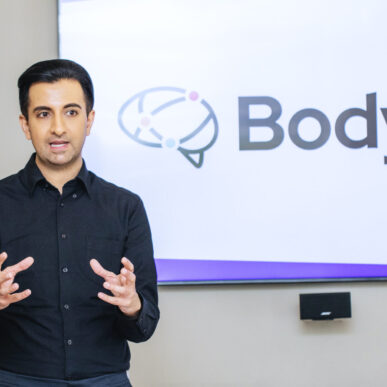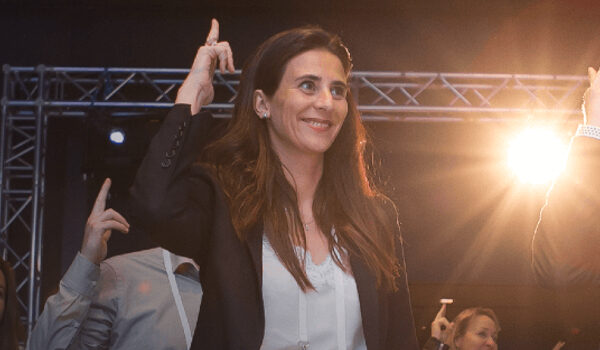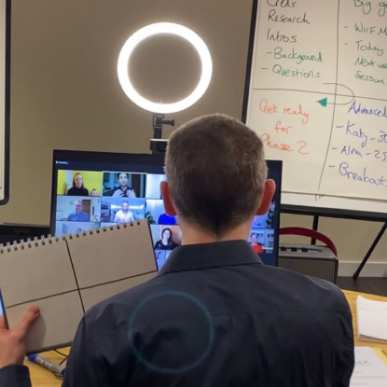I have to confess, the first time I saw an AI platform come up with a slide deck, I was gobsmacked. It felt like I was looking into the future, and that the days of grappling with clumsy PowerPoint and Keynote formatting were finally behind us.
There’s no question that artificial intelligence is everywhere right now – and if you’re not using it already, you’re probably talking about it. Over the last five years, there’s been an explosion of AI platforms emerging, and in the workplace, people are using them to bolster their communication in a variety of ways, such as writing emails, summarising meetings and even creating entire slide decks.
The promise is appealing. Type in a topic into a prompt box and within seconds platforms like Gamma, Beautiful.ai or even Canva’s Magic Design can generate a deck of slides, neatly laid out with your company branding, colour palette and vibrant images.
Put it another way: using AI means no more staring at a blank PowerPoint at 10pm. No more fiddling with text boxes that will not line up, or elements which mysteriously appear that you thought you’d deleted.
The technology is hugely impressive, that much is clear. The question is: should you let AI design your slide decks for you? And the answer to that is much less clear.
Let’s take a look at why…
What AI is good at
There’s no question that AI appears impressive when it comes to slide design. In fact, AI is particularly useful for:
- Speed: AI is brilliant at removing the pain of the blank slide. With some carefully thought-out prompts, you can have text, suggested layouts, and even on-brand colours or imagery within seconds. That could save you hours of work.
- Tidying things up: Formatting is not fun. If you have ever spent 15 minutes nudging a text box into place, you will know what I mean. Tools like Gamma or Beautiful.ai can automate those design tweaks so your slides look neat, professional and consistent.
- Generating ideas: Not sure how to visualise data? Tome can suggest charts. Looking for a metaphorical image? Canva’s AI features can come up with examples you might not have thought of. AI is good at being that partner and supporter.
- Consistency: Left to our own devices, many of us create “Frankenstein slides,” a random mix of fonts, colours, and styles cobbled together. AI tools apply a uniform design language in seconds.
- Visualising data: Data can be dull and time-consuming to pick through. AI platforms can take in all of your data, charts, research and information and instantly pick out important points, trends and stories, as well as making great visualisations to bring that data to life.
Essentially, if your goals are efficiency and consistency, AI can be a lifesaver.
Where AI falls short
But here is the reality: AI does not think like you. And that is where it gets tricky.
AI does not know your audience
It’s always useful to remember that, despite its name, AI is not actually ‘intelligent’. The platform you are using does not understand your audience and the nuances of the people sitting in front of you. It does not know what your boss cares about, what your client worries about, or what will grab your team’s attention at 9am on a Monday. You do.
This means that although AI might create beautiful, slick slides for you, if they do not connect with your audience, it is wasted effort.
It can be easy to fall into the trap of trusting what AI has generated for you, especially when it looks impressive – but your human experience is what will really make the difference when it comes to deciding if it is right for your audience or not.
AI does not know your story
Your presentation is not just a sequence of information. It is a story. You know which details to leave out, which examples to highlight and which emotional parts to include.
AI can generate “content,” but it does not understand your strategy. It does not know that one powerful image will do more than three bullet points, unless you tell it to. It does not know that your audience responds better to humour than to jargon. It does not know which slide is meant to make them lean in, and which one is meant to make them nod.
That insight belongs to you.
AI tends to produce text and data heavy slides
One of the biggest drawbacks of using AI for slide creation is its tendency to overload slides with text.
Most AI slide tools are powered by language models, which means their default instinct is to generate paragraphs and bullet points rather than concise, impactful messaging. The result is often slides that read more like a condensed document than a visual aid.
Audiences don’t absorb information best when slides are crammed with text. Research and presentation best practices consistently show that less text is more effective – the slide should highlight key points, while the speaker provides the detail. Too much text encourages people to read instead of listen.
Strong, well-chosen visuals are far more powerful at supporting memory and keeping engagement high. Yet, AI tools rarely excel at sourcing or prioritizing compelling imagery. Instead of leaning into bold visuals, they often default to safe but uninspired layouts heavy on words. This means presenters often need to go back in and trim down the copy, replace it with visuals and reframe slides so they work as true presentation aids rather than walls of text.
AI cannot tell you how to present your slides
One of the most powerful tools you have as a presenter is control over timing. Deciding what to show, when to show it and how much to show at once can make or break how well your audience engages with your slides.
AI cannot do that for you. It cannot sense the moment when the room is leaning forward, waiting for your next point. It cannot tell you when to pause before revealing the big number, or when to keep a slide hidden so the audience is focused on your story instead of reading ahead.
And timing is not just about when you put a slide up. It is also about how you reveal the content within the slide. If everything appears at once, your audience’s attention is split. They start reading the third point while you are still explaining the first. The impact is lost.
Think of something like a quarterly results meeting. If you put all the figures on screen in one go, people start scanning for the number that matters to them. By the time you have worked your way to the total, they are already ahead of you. But if you choose to reveal the results step by step, building the story toward the final figure, you keep the attention exactly where you want it.
That sense of pacing and release is something only you can decide. Maybe it is one striking image. Maybe it is a single headline, revealed before you show the data that supports it. Maybe it is the number that makes everyone sit up straighter in their seats.
AI cannot control the rhythm of your delivery, and rhythm is often what makes the difference between slides that are skimmed and slides that stick.
AI cannot judge transitions
AI-powered slide tools have a tendency to insert transitions and animations by default, often more than you might want. Here’s why:
- Optimizing for “visual appeal”: Many AI tools are trained to make slides look dynamic and polished. Their default behaviour is to add motion (fades, zooms, or morphs) to avoid slides looking static.
- Consistency bias: If it detects repeated elements (like bullet points or images), it may automatically animate them in a sequence to appear “professional.”
- User convenience: The AI assumes you want a finished-looking deck with minimal manual effort, so it pre-applies transitions and animations.
The catch: This can lead to over-animated slides, which distracts from your content. AI rarely distinguishes between “necessary” motion and “just because it looks fancy,” so it errs on the side of adding effects.
A subtle fade can help you build a point. But a spinning, bouncing graphic? That is just distracting. AI will not know the difference. It will decorate because it can, not because it should.
The human touch that makes the difference
Think about the best presentations you have ever seen. Were they memorable because the slides were perfectly aligned? Probably not. They were memorable because the person delivering them had thought deeply about their message and how to make it matter to you.
AI can polish, structure and design, but only you can:
- Decide what really matters.
- Simplify complex ideas into something clear.
- Tell stories that stick.
- Add energy and warmth through your voice and presence.
That is the difference between slides that are merely professional-looking and slides that actually work.
A useful partnership
So, does this mean we should abandon AI altogether? Not at all.
Think of AI as your junior designer. It can get you started. It can give you options. It can speed up the fiddly bits so you can focus on the important stuff.
But it should never be the decision-maker. The decision-making is yours.
For example:
- Let AI suggest a chart layout but decide whether you actually need a chart at all.
- Let AI create a draft slide deck but ask yourself which slides are essential and which are clutter.
- Let AI polish the formatting but then go through and strip back anything that distracts from your story.
If you rely entirely on AI, you risk ending up with slides that look fine but do not land with your audience. You risk missing the moments where less is more. You risk forgetting that communication is about connection, not decoration.
AI will not stop you from putting up too many bullet points. AI will not tell you to pause, breathe and let the silence do the work. AI will not remind you that your audience does not want all the data, they want the data that matters to them.
That is why your input and control is irreplaceable.
AI is a tool. A powerful one. Use it to save time, spark ideas, and tidy up your slides. But do not hand over control of the thinking. That is the part that makes your message memorable.
Want to go further?
At Body Talk, we help professionals take their presentations from ordinary to extraordinary. If you want to learn how to design slides that truly support your message, and how to deliver them with confidence and impact, get in touch. We would love to help you make your next presentation one your audience will never forget.

















